Last Wednesday - 5 December - the organisor of the Vuelta a España has announced the track of the 93rd edition, the 2008 edition, in the auditorium IFEMA in Madrid.
The Vuelta a España 2008 starts on Saturday 30 August 2008 in Granada and finishes on Sunday 21 September 2008 in the Spanish capital Madrid.
In this article you'll read more about the detailed track, the details of all start and finish cities and some additional information about each stage ...
Unipublic, the organisor of the Vuelta, used this opportunity to present a new version of the Vuelta website. This website, created by mastercom, however doesn't show any innovations next to a new graphical design!
CONTINUE READING AFTER THIS ADVERTISEMENT
The start: 6 relatively easy stages
The Vuelta starts - just like the Giro d'Italia 2008 and not like the Tour de France 2008 - with a team time trial and for the Vuelta this will take place in the Parc Technologique Sciences de la Santé in Granada.For Granada the Vuelta is not really new any more since the Tour of Spain already had 21 stage starts and 18 stage finishes in this city (the first time was in 1935). In 2005 the Vuelta also started from Granada, at that time with an individual time trial won by Denis Menchov.
The time trial which will announce the start of the Vuelta 2008 on 30 August 2008 will be done in teams on a flat track of about 7 kilometers.
The next day the riders will start from Granada to the stage finish in Jaén after 167 km. This is a flat stage but the riders will see the first mountain of this Vuelta, the col de Las Encebras (third category) after 45,6 km. When the riders will cross the finish line in Jaén they will not have finished this stage yet since the winner will only be known once they cross it for the third time. In the mean time they will ride over a pretty tough local circuit (with two hills at the end).
On Monday 1 September Jaén will still be part of the Vuelta party but that day for the start of the third stage which will finish after 165 kilometers in Córdoba. Again a flat stage with one mountain, the Alto de San Jerónimo (2nd category) with its top at 19 kilometers from the finish. This mountain could well determine the winner of this stage ... if not it will again be a stage for sprinters.
The city in which the stage finished the day before will again be the start of the next day's stage since the fourth stage starts from Córdoba for a 153 kilometer almost flat track to Puertollano. The streets of Puertollano will be prepared for a sprint since with only one third category mountain, the Alto de la Sierra de Cardena, there's a big chance the whole pack arrives together.
After a transfer of about 200 kilometers the riders will be ready for the start of an individual time trial which starts and finishes in Ciudad Real. The track which is pretty flat and has a distance of about 40 kilometers will allow time trial specialists to take some advance in the general ranking before the mountain stages start two days later ...
On Thursday 4 September the last stage before the mountains will start in Ciudad Real and on the 162 kilometer track the Alto de Arisgotas (third category) at 59 km from the finish will be the only difficulty. Again the winner of this stage will only be known when he crosses the finish line for the third time. The riders will do two local tours ending in a two kilometer hill at 3% and with the finish line somewhere in that climb in Toledo.
On Friday 5 September the riders can take some rest after all the efforts of the first week and just before the mountain stages start.
This rest day will also be used for a big transfer to the start of the other day's stage, almost 600 kilometers away from Toledo.
The Pyrenean mountains
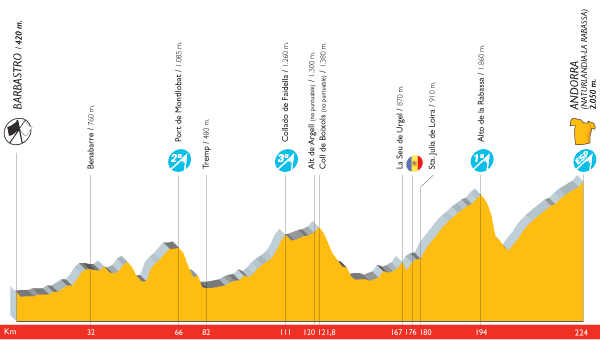
This is not only the first mountain stage, but - with its 224 kilometers - also the longest stage. The climbers who lost some time in the first time trial can easily win this back in the 4 mountains of this stage: the Port de Montllobat (2nd category), the Collado de Faidella (3rd category) and after having crossed the border with Andorra the Alto de la Rabasse and the mountain top arrival at Alto de Naturlandia - La Rabassa at 2050 meters.
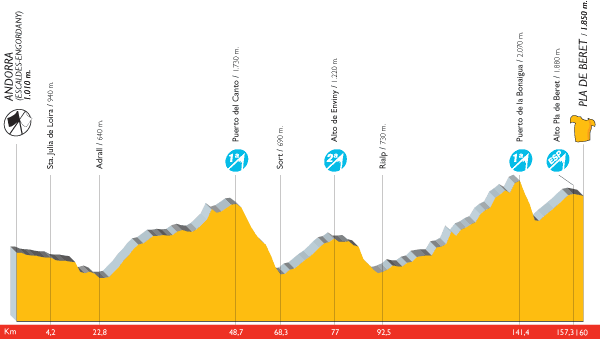
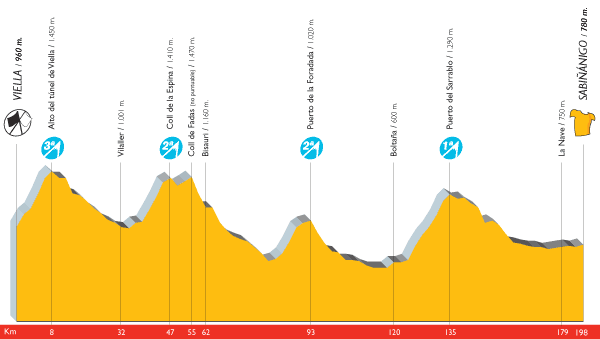
The intermediate stages
After these Pyrenean stages, on Tuesday 9 September there will be a flat stage which is perfectly fit for one or more escapes or otherwise for a sprint at the end since the stage finish is on an almost flat and very open (high risk on sidewind) track. The stage starts from Sabiñanigo and after the two mountains of this stage, the Puerto del Oroel and the Alto de Casas de Expe (both 3rd category), the riders will arrive in Zaragoza after 173 kilometers.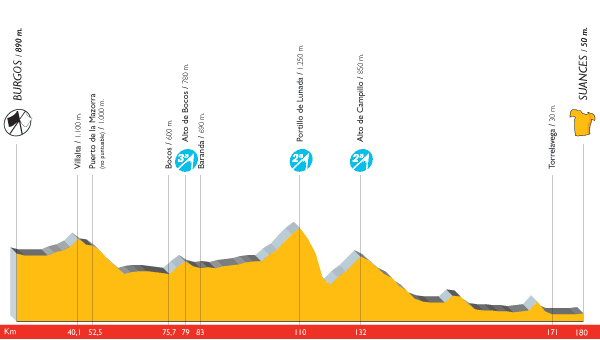
Even more mountains
On Thursday 11 September the riders are back in the mountains with - after the start from Burgos - three mountains, one third category, the Alto de Bocos and two 2nd category, the Portillo de Lunada and the Alto de Campillo. The stage will than continue quietely to Suances at 180 kilometers from Burgos.On Friday 12 September the riders can again rest before starting the last week with even more mountain stages.
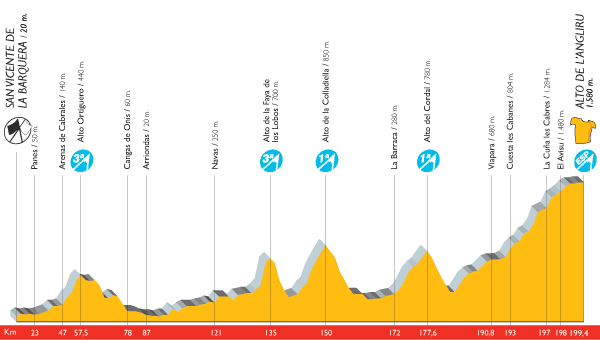
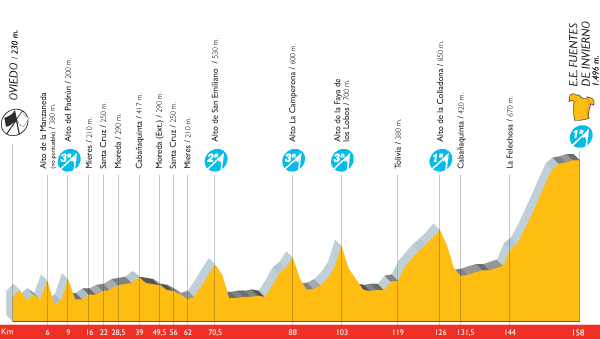
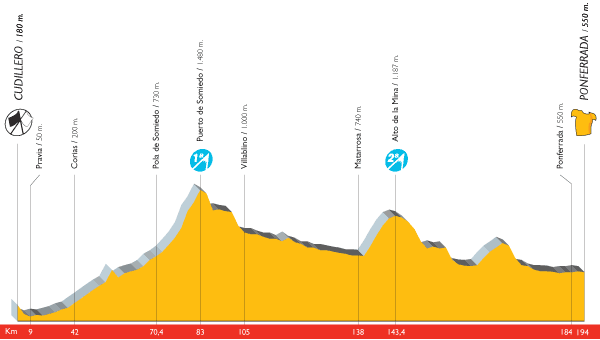
CONTINUE READING AFTER THIS ADVERTISEMENT
The end
After the mountains, Tuesday 16 September will probably be a quiet day because after the Alto del Acebo (1st category) just after the start from Ponferrada only a possible side wind can give additional difficulties in this stage which steadily goes down to Zamora.The next day Zamora is also the start city for the 17th stage and 160 kilometers further the riders, probably pretty tired after 3 weeks on their bike, will arrive in Valladolid.
On Thursday 18 September Valladolid is the start city for a 179 kilometer stage which in its second part proposes the "easy" side of the col de los Leones (third category) followed by a descent to Las Rozas.
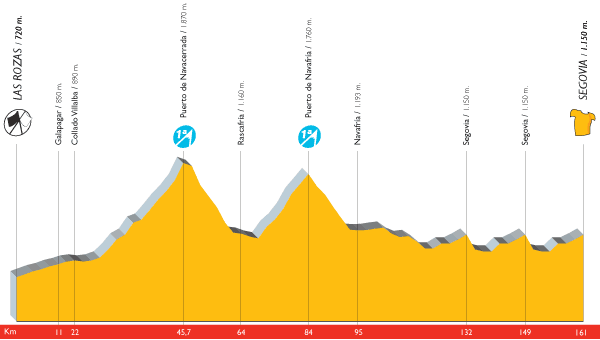
The forelast stage of the Vuelta 2008 is an individual mountain time trial on one of the mountains of the previous day's stage, the col de Navacerrada. The day before the riders climbed this mountain on the Madrid side while on Saturday 20 September the Segovian side will be used once they leave La Granja de San Ildefonso (16 kilometers).
This start city has never seen a Vuelta stage start before, but there's something else which links this city to the Vuelta: this is where every year the Vuelta trophy is being created in the Real Fábrica de Cristales!
The last stage will probably be calm and that will be a good opportunity for the Vuelta winner to be at the front of the pack with his team mates to celebrate his victory. This stage starts from San Sebastián de los Reyes just north of Madrid and will finish - probably in a sprint - on the Paseo de la Castellana in Madrid, just like previous years.
The Vuelta 2008 in numbers
- 21 stages- total distance: 3.169 kilometers
- 10 flat stages, 8 mountain stages, 1 team time trial (7 km), 1 individual time trial (40 km) and 1 mountain time trial (16 km)
- 5 mountain top finishes
- 3 highest level category mountains (Andorra (Naturlandia-La Rabassa), Pla de Berret and the Angliru), 13 first category mountains, 9 second category mountains and 15 third category mountains
- 7 new stage cities: 4 as stage start (San Vicente de la Barquera, Cudillero, La Granja de San Ildefonso and San Sebastián de los Reyes) and 3 as stage finish (Naturlandia - La Rabassa (Andorra), Suances and E.E. Fuentes de Invierno)
- 2070: this highest mountain of the Vuelta 2008, the Col de la Bonaigua is this Vuelta's roof top ...
- 224: the number of kilometers of the longest stage, from Barbastro to Naturlandia - La Rabasse in Andorra
The Vuelta 2008 map
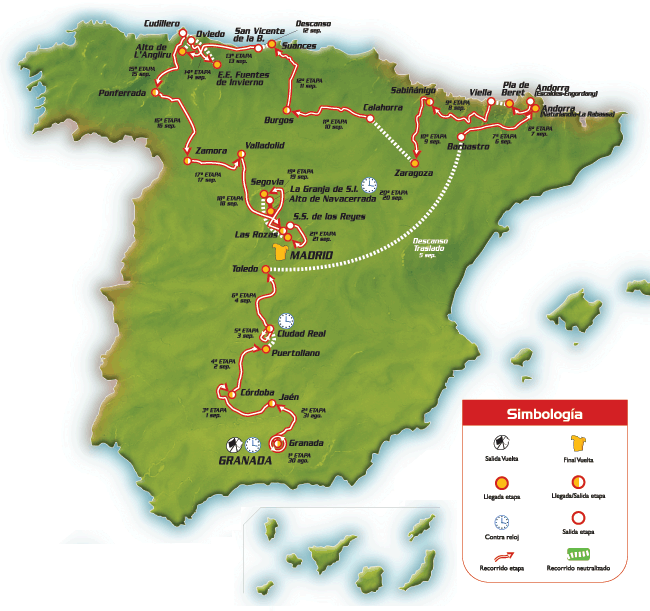
The overview of Vuelta 2008 stages
| Date | Stage | Type* | Start | Finish | Distance |
| 30/08 | 1 | TTT | Granada | Granada | 7 |
| 31/08 | 2 | P | Granada | Jaén | 167 |
| 01/09 | 3 | P | Jaén | Córdoba | 165 |
| 02/09 | 4 | P | Córdoba | Puertollano | 153 |
| 03/09 | 5 | ITT | Ciudad Real | Ciudad Real | 40 |
| 04/09 | 6 | P | Ciudad Real | Toledo | 162 |
| 05/09 | - | - | REPOS | - | - |
| 06/09 | 7 | M | Barbastro | Naturlandia - La Rabassa (Andorra) | 224 |
| 07/09 | 8 | M | Escaldes-Engordany (Andorra) | Pla de Beret | 160 |
| 08/09 | 9 | M | Viella | Sabiñánigo | 198 |
| 09/09 | 10 | P | Sabiñánigo | Zaragoza | 173 |
| 10/09 | 11 | P | Calahorra | Burgos | 178 |
| 11/09 | 12 | M | Burgos | Suances | 180 |
| 12/09 | - | - | REPOS | - | - |
| 13/09 | 13 | M | San Vincente de la Barquera | Alto de l'Angliru | 199 |
| 14/09 | 14 | M | Oviedo | Fuentes de Invierno | 158 |
| 15/09 | 15 | M | Cudillero | Ponferrada | 198 |
| 16/09 | 16 | P | Ponferrada | Zamora | 185 |
| 17/09 | 17 | P | Zamora | Valladolid | 160 |
| 18/09 | 18 | P | Valladolid | Las Rozas | 179 |
| 19/09 | 19 | M | Las Rozas | Segovia | 161 |
| 20/09 | 20 | MTT | La Granja de San Ildefonso | Alto de Navacerrada | 16 |
| 21/09 | 21 | P | San Sebastián de los Reyes | Madrid | 110 |
Légende type d'stage :
- TTT = team time trial
- ITT = individual time trial
- MTT = mountain time trial
- P = flat stage
- M = mountain stage
All maps and images in this article are © Unipublic / La Vuelta a España. door Thomas Vergouwen
Vond u dit artikel interessant? Laat het uw vrienden op Facebook weten door op de buttons hieronder te klikken!
no comments yet | 15493 views
this publication is published in: Vuelta a España | Cycling general (except Tour de France)





 by marco1988 over
by marco1988 over